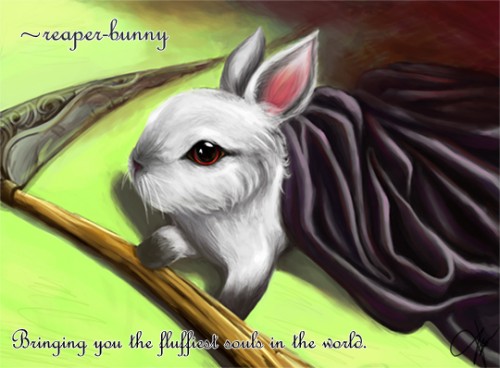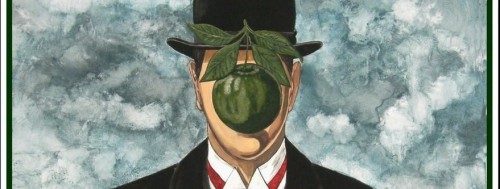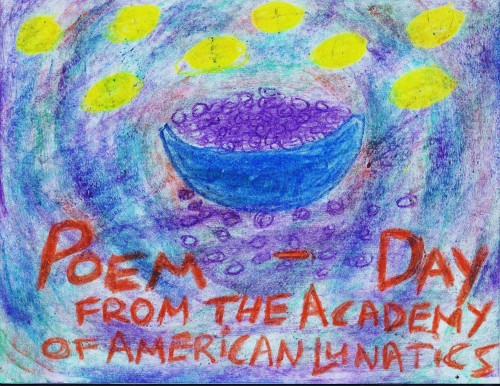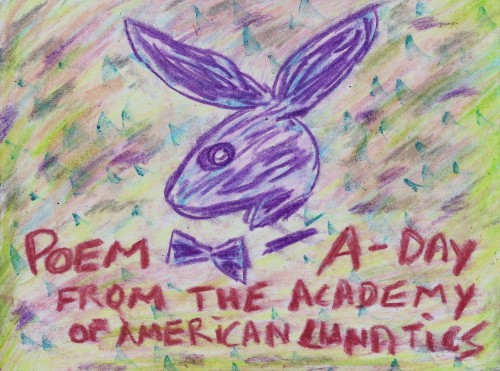……National Poetry Month Death Match #2……
******
April is winding down and I’m not really sure how much was settled with the first National Poetry Death Match (ie, my soul is still soooooo confused) so in order to settle things I’ve decided to bring out two more big, passionate and extremely eloquent mercenary lovers for a second “Death Match” where I hope the “disturbing contraries of my soul” can be brought into line, can be made to heal, can be brought into a beautiful, “poetic” harmony.
******
******
And, so, the second National Poetry Month death match is between Russell Jaffe and Seth(x) AbraHaM$on. And, no, this is not Seth Abramson, it is, instead, a well known writer who has chosen, here for the ring of this Death Match, to be know as Seth(x) AbraHam$on.
******
National Poetry Month: More poems for more people sounds good to me
by Russell Jaffe
Look: Poetry can be a real distance READ MORE >
April 29th, 2014 / 9:00 am
……National Poetry Month Death Match #1……
April, because of National Poetry Month, is a traumatic ordeal of a time for me.
A prevailing, I guess, part of me thinks “What a total bunch of fucking bullshit”– and for the past few years all April long I’m in a grouchy stupor-rage making snide and mean remarks, pissing on anything even remotely “poetry,” and relentlessly posting up pictures of beached whale carcasses.
And yet–a part of me identifies with this impressive cadre and camaraderie of poetry munchkins gathered squawking and encouraging and reassuring each other on the cliffs of poetry each April because, well, it must be a good thing. It must be, right?
And so this year I’ve decided to face the disturbing contraries of my soul and the way they bristle and soft-feather up at National Poetry Month by setting up, as any good Caesar of the soul, some death matches. And in each case the death match will consist of a “for” and “against” stance fought out between two of my friend surrogates. And in each case I’ll stand up above the fray with thumb at the ready.
******
And, the first death match is between Reb Livingston and Jereme Dean.
******
NaPoWriMoHoHoHo
by Reb Livingston
What’s ruining/killing poetry this month? Well, it’s April so that must mean the culprit is National Poetry Month. Or so claims my anti-NaPoMo poet pals on social media.
April 21st, 2014 / 3:10 pm
POEM-A-DAY from THE ACADEMY OF AMERICAN LUNATICS (#15)

Jessalyn Wakefield can literally teleport. You can literally find her work at amihuman.net. Farren Stanley lives in Santa Fe and is published or forthcoming in places like Handsome, Front Porch, RealPoetik, Caketrain, H_NGM_N, New Delta Review and Greying Ghost Press.
A Rabbit in Labor
by
Farren Stanley / Jessalyn Wakefield
The Rabbit Poems are a collaborative project between myself and Farren Stanley. We wrote A Rabbit in Labor while I was in Alabama, visiting Farren, who was working on her MFA in Tuscaloosa. We spent a lot of time doing shots of Fireball and drinking Budweiser and watching Jeopardy at her bar, Egan’s. There were also late night topless pool crashings, sexy coeds, hot dance parties, and a fucking lot of writing. It was killer. I dropped out of my undergrad three semesters in, so I’m sure my two weeks in Tuscaloosa packed in all the grad school I might ever have needed.
We spent a lot of time doing shots of Fireball and drinking Budweiser and watching Jeopardy at her bar, Egan’s. There were also late night topless pool crashings, sexy coeds, hot dance parties, and a fucking lot of writing. It was killer. I dropped out of my undergrad three semesters in, so I’m sure my two weeks in Tuscaloosa packed in all the grad school I might ever have needed.
note: I’ve started this feature up as a kind of homage and alternative (a companion series, if you will) to the incredible work Alex Dimitrov and the rest of the team at the The Academy of American Poets are doing. I mean it’s astonishing how they are able to get masterpieces of such stature out to the masses on an almost daily basis. But, some poems, though formidable in their own right, aren’t quite right for that pantheon. And, so I’m planning on bridging the gap. A kind of complementary series. Enjoy!
February 20th, 2014 / 10:57 am
5 Points: The Narrow Circle (by Nathan Hoks)
***
Nathan Hoks is one of my favorite writers. And this is a 5 point review of “The Narrow Circle,” a National Poetry Series winner selected by Dean Young (Penguin Books, 2013).
1) At times the careful and elegant lines and images of The Narrow Circle, a book moving and blurring between “Interior” and “Exterior,” feel like the work of a classic Surrealist. A Magritte, let’s say. And, here I’ll quote a poem in its entirety:
***
A lily is sprouting from my head.
First I love it, then I want it dead.
And now I’ll quote the beginning of the poem that follows LILY OF THE INTERIOR because it spiked in me the Primitive and Eden-Like scenes work of Henri Rousseau, who came to mind, also, from time to time, as I read through this collection:
The invisible bird is still hissing near
Her head.
2) Inside and out through much of these poems there is a thriller-horror movie feel. The feel of something morphing. Of an evil or strangeness (an alien sort of thing) building. Impending. Within and out.
Of soluble phosphates will fill with
Algal blooms and kill the fish and plants
The same green spot is growing inside me.”
And
“…my wife and I stand in the middle and call it
The inside. A leaf is growing out of our face.”
3) Quentin Tarantino’s movie-making came to mind, also, as I read through The Narrow Circle. I mean careful and exact tension building (think of the farmhouse scene in Inglourious Basterds, the terrified family hidden beneath the floorboards) and culminating from time to time, in waves, like a lily, exploding, facially:
Nathan Hoks is a 50/50 blend
Gunpowder and guts. Film comes
Whirring out of his mouth.
Rusted screws hold his fingers to hands.
Flies hang around his buttocks.
Shoots and pods are sprouting from his intestines.
Nathan Hoks is a fork in the egg yolk.
Nathan Hoks is a penitentiary.
Nathan Hoks lives inside himself
Where he is choking on the curtains, READ MORE >
February 19th, 2014 / 4:00 pm
POEM-A-DAY from THE ACADEMY OF AMERICAN LUNATICS (#14)

TJ Lyons is in California doing things that dudes usually do. His first book, Things, will be out soon from somewhere awesome. Things are always what they seem. tjisadude.tumblr.com
I think I sleep in a peel that fits me better than a collar
by
T.J. Lyons
This poem came from my experience living as a banana in a Safeway for nine days before the produce people noticed me, and then they marked me down. An old woman with a pegleg bought me. This will appear soon in the ebook, The Wind Cannot Remove the Stench in My Bones, with art by Andrew Jurado.
in a Safeway for nine days before the produce people noticed me, and then they marked me down. An old woman with a pegleg bought me. This will appear soon in the ebook, The Wind Cannot Remove the Stench in My Bones, with art by Andrew Jurado.
note: I’ve started this feature up as a kind of homage and alternative (a companion series, if you will) to the incredible work Alex Dimitrov and the rest of the team at the The Academy of American Poets are doing. I mean it’s astonishing how they are able to get masterpieces of such stature out to the masses on an almost daily basis. But, some poems, though formidable in their own right, aren’t quite right for that pantheon. And, so I’m planning on bridging the gap. A kind of complementary series. Enjoy!
February 17th, 2014 / 11:26 pm
POEM-A-DAY from THE ACADEMY OF AMERICAN LUNATICS (#13)

Alexandra Naughton does a lot of things and her name is very search engine friendly. Her first book, I Will Always Be Your Whore, was published by Punk Hostage Press in January, 2014.
Love Song #1
[Ava Adore]
by
Alexandra Naughton
![]()

Someone: “HTML Giant is so sexist…”
Nigel Tufnel: “What’s wrong with bein sexy?”
![]()
note: I’ve started this feature up as a kind of homage and alternative (a companion series, if you will) to the incredible work Alex Dimitrov and the rest of the team at the The Academy of American Poets are doing. I mean it’s astonishing how they are able to get masterpieces of such stature out to the masses on an almost daily basis. But, some poems, though formidable in their own right, aren’t quite right for that pantheon. And, so I’m planning on bridging the gap. A kind of complementary series. Enjoy!
January 28th, 2014 / 9:41 pm
POEM-A-DAY from THE ACADEMY OF AMERICAN LUNATICS (#12)

Russell Jaffe runs the Strange Cage reading series in Iowa City and his website is russelljaffeusa.com
untitled from STUMBLE X THE AIR STASIS BREATH
by
Russell Jaffe
I wrote the untitled poems in STUMBLE X THE AIR STASIS BREATH in winter. I tried hard to do a minimalist take on poetry as a lifelong proud maximalist. Now that chap-sized collection is a part of a bigger as-yet-unpublished manuscript called LOVER TO and is retitled INTROVERT TO. Everything you know is wrong.
STASIS BREATH in winter. I tried hard to do a minimalist take on poetry as a lifelong proud maximalist. Now that chap-sized collection is a part of a bigger as-yet-unpublished manuscript called LOVER TO and is retitled INTROVERT TO. Everything you know is wrong.
![]()
note: I’ve started this feature up as a kind of homage and alternative (a companion series, if you will) to the incredible work Alex Dimitrov and the rest of the team at the The Academy of American Poets are doing. I mean it’s astonishing how they are able to get masterpieces of such stature out to the masses on an almost daily basis. But, some poems, though formidable in their own right, aren’t quite right for that pantheon. And, so I’m planning on bridging the gap. A kind of complementary series. Enjoy!
January 25th, 2014 / 3:36 pm
POEM-A-DAY from THE ACADEMY OF AMERICAN LUNATICS (#11)

Penny Goring lives in London. She makes things, and collaborates with Hella Trol Buzy to make other things.
please make me love you
by Penny Goring
![]()
i wrote it on new years day. i used that can be my next tweet, getting computer generated mashups of my recent tweets, then reshuffling, discarding, and adding words. when a line is done i tweet it. because: it’s faster than opening another tab, it makes writing less lonely, it’s interesting to see what lines get favd/retweeted/ignored, and seeing my lines in the twit stream helps me get distance. when i felt like i’d made enough, i copy/pasted each tweet into openoffice and did edits. i like repetition, variations. i feel self-indulgent when i write lists – it is a falling. on new years day i wanted to fall in love.
when a line is done i tweet it. because: it’s faster than opening another tab, it makes writing less lonely, it’s interesting to see what lines get favd/retweeted/ignored, and seeing my lines in the twit stream helps me get distance. when i felt like i’d made enough, i copy/pasted each tweet into openoffice and did edits. i like repetition, variations. i feel self-indulgent when i write lists – it is a falling. on new years day i wanted to fall in love.
![]()
note: I’ve started this feature up as a kind of homage and alternative (a companion series, if you will) to the incredible work Alex Dimitrov and the rest of the team at the The Academy of American Poets are doing. I mean it’s astonishing how they are able to get masterpieces of such stature out to the masses on an almost daily basis. But, some poems, though formidable in their own right, aren’t quite right for that pantheon. And, so I’m planning on bridging the gap. A kind of complementary series. Enjoy!
January 15th, 2014 / 8:39 pm
Interview With Luis Panini
 Luis Panini is one of the most talented writers you’ve never heard of. With writing that recalls the best of Franz Kafka, Lydia Davis, David Foster Wallace, and Julio Cortázar, it is a regret that his writing can not be read in English (until now! see below). I recently sat in on a class at CalArts where he was a special guest in my friend Laura Vena’s class on Latin American literature, and it was a huge pleasure to hear him talk about his writing and thought processes. Laura Vena translated a few of his short stories (or fragments) into English, the results of which can be found below, and so I’m hugely happy and excited to share this interview here and debut these new translations of his work into English.
Luis Panini is one of the most talented writers you’ve never heard of. With writing that recalls the best of Franz Kafka, Lydia Davis, David Foster Wallace, and Julio Cortázar, it is a regret that his writing can not be read in English (until now! see below). I recently sat in on a class at CalArts where he was a special guest in my friend Laura Vena’s class on Latin American literature, and it was a huge pleasure to hear him talk about his writing and thought processes. Laura Vena translated a few of his short stories (or fragments) into English, the results of which can be found below, and so I’m hugely happy and excited to share this interview here and debut these new translations of his work into English.
Janice Lee: In your other life, you’re an architect and furniture designer. I’m interested in how this work and mode of thinking influences your stories. For example, the preciseness of your language, the constructedness of your stories as rigid and stable structures, your attention to spatial details and spatial relationships, and the existence of people and objects in physical environments rather than in relation to each other.
Luis Panini: My academic background has not only influenced the way in which I think about stories before I actually write them but also it has made me think about overall structures when I am constructing (not writing) a book, whether is a collection of short fiction, a novel, a book of poems or some piece of writing that does not necessarily falls into these ankylosing categories. Spatial awareness is very important for me since it is ultimately where the “game is played” and this is why I frequently try to inject some sort of symbolic meaning to both, the spaces my characters inhabit and the objects they come in contact with. In a way, what I am trying to accomplish is to integrate these “architectural objects” into the narrative in such a way that these become as important as the characters or the story itself. It is about translating the mere functionality of a space or an object into an emotional component in the writing process or how this space or object is acknowledged and assimilated by the reader. Duchamp’s “Fountain” comes to mind. He managed to transform a simple urinal into an object charged with many layers of meaning by placing it within the confines of a “sacred space.” Outside the museum, Duchamp’s piece is nothing but a urinal. Inside the museum is everything but a urinal because the reading conditions of this object have been transgressed. This is the sort of relationships I like to establish between my characters and the space they move about.
JL: You’ve described your stories as vignettes or fragments, and I think they operate in this way, but too, at the same time, they seem like such self-contained and intentionally built structures that do have set boundaries. Can you talk a bit more about the general shape of your individual stories?
LP: I did refer to those texts (the ones collected in my second book) as vignettes or fragments because that is truly what these are. They are absolutely self-contained pieces of writing. I like to think that the most interesting building block in writing is not the sentence, the paragraph, the chapter, etc. but the fragment, because a fragment does not require a beginning or an end, it does not need to tell a whole story to work, it does not have to acknowledge the fragment that precedes it or follows it and I find this to be truly liberating, a sense that I do not get when I take a different approach. About a year or two ago I finished writing a book that deals with memory and it is comprised of more than one hundred fragments. There are two versions of that book. In one version the fragments follow a chronological order of events and in the other version the fragments appear in the order in which they were written, the order in which I remembered a loved one who died recently. I chose to write about that story through fragments because in a way I wanted to emulate the mechanisms of memory and a fragmentary approach made perfect sense since I could experiment with the elasticity of the overall structure (or lack of one) by allowing a virtually infinite number of permutations. This also allowed me to set very strict boundaries on a fragment bases that I had to respect as I was writing each line. Every time I deviated in any way from those boundaries, the fragment did not work. It felt like an ill-conceived part of a whole. Through this method of writing I learned about the shape of not just individual stories but also how these can be connected in a book and how they interact among themselves by borrowing, cannibalizing from each other, etc. A book composed of fragments can be dozens of different books, only limited by the sequence you end up choosing.
JL: I know you are a Béla Tarr fan too, and I find that there are some resonances in your work with Tarr’s fans. For example, the focus in your stories is often on a person’s existence in a space or situation, and the story settles in on the details of the environment, constructing a scene that becomes a sort of story, rather than a story that is based on action and resolution. This reminds me of the indifference of the camera in Tarr’s films too, where often the setting is there before a character enters, and remains there after the character is gone. What are your thoughts on this observation?
LP: Sometimes I think that filmmakers are the ones who truly influence my creative process and writing methods, much more than literature in general or specific writers and books, and this has nothing to do with the fact that I live in Los Angeles, a city in which if you mention that you are a writer most people immediately ask you what screenplays have you written. Béla Tarr is one of these auteurs (I can’t tell you how much I enjoyed seeing that old man peeling potatoes in “The Turin Horse”), but also I am fascinated with the way other directors choose to tell stories, like Michael Haneke, Yorgos Lanthimos, and my personal favorite Ruben Östlund. I am not trying to say that my literary work has a cinematic quality or that it could easily be translated onto the screen, but this element becomes quite obvious since I tend to favor heterodiegetic narrators in most of my texts. I like to take it to the extreme, turning them into machine-like narrators which can be perceived as actual cameras panning through multiple rooms in a residence to create some sort of long shot composed by zoom-ins, abrupt cuts, blurs, etc. My vignette titled “The Event” is an example of this. After the character has “disappeared” in a very tragic way the camera goes back into the apartment where it all began and stays in recording mode to capture the solitude of the space, which to me is far more important than the demise of the actual character. In another vignette the narrator also acts as a camera that moves inside of a mansion to capture many of the possessions of a lonely man dying of complications related to an immunological disease. I was not interested in that man’s story specifically, but in how I could construct one by describing the pieces of furniture and ornaments he owns, the art hanging on his walls, and the materials and finishes of his home. I guess by doing this I am trying to illustrate some sort of terror that sometimes keeps me awake at night, the fact that after one dies everything else remains in its place, unaltered, because we are that insignificant. And it is this sense of pervasive malaise what informs most of my writing.
JL: I’m affected deeply by level of compassion and human dignity present in Tarr’s fans. On this subject, Andras Balint Kovacs writes:
“The man, whose philosophy despises ‘humanist’ feelings like compassion and pity, suddenly and certainly unwillingly, manifests the deepest compassion for a helpless living being, a beaten horse. This event, says Krasznahorkai, is ‘the flashing recognition of a tragic error: after such a long and painful combat, this time it was Nietzsche’s persona who said no to Nietzsche’s thoughts that are particularly infernal in their consequences.’ This is the example which leads to a conclusion about the universality of this feeling: ‘if not today, then tomorrow… or ten, or thirty years from now. At the latest, in Turin.’ … an attitude or an approach to human conditions, which Tarr fundamentally shares with Krasznahorkai… Both authors have a fundamentally compassionate attitude toward human helplessness and suffering in whatever situation it may manifest itself, and of whatever antecedent it may be the result.”
In Tarr films, compassion can exist without moral judgment, or, in other words, “In the Tarr films human dignity is not based on morality. It is based on the fact that in spite of their absolutely hopeless and desperate situations the characters remain what they are, however low what they are brings them.”
This simultaneous closeness and distancing, this empathy is ever-present in your stories for me too. For example, in “Mathematical Certainty,” there is a deep care in the description of the hat, but also in the generous curiosity afforded to the man with the brain tumor. I also recently heard Lydia Davis talk about description, and said something like, “In order to describe something, you have to love it. Even if it’s ugly, like an old shoe, you have to love it in a way to really describe it.” The preciseness of your language and the kind of curiosity afforded by such a detail as the length between the interior wall of the hat and the tumor, seems like a generous gesture in a way. What are your thoughts?
LP: I believe empathy and compassion is what drove me to write the vignettes included in my second book, as strange as that may sound given the dark nature of the overall subject matter of those texts, which is ill will. In fact, I can pinpoint the exact moment that acted as the catalyst. Back in 2006 there was a terrible brush fire, which consumed an enormous area near Los Angeles. For some reason that I yet have to comprehend a news show chose to broadcast a recording with no “viewer discretion advised” warning beforehand. I saw the body of a fallen hare partly carbonized. It was still moving, shaking the rear legs, convulsing, agonizing. And it affected me so much because animal suffering is something I simply cannot deal with. So this visceral reaction prompted me to explore this feeling in different ways, in fact so many that soon became a book about ill will. Ill will towards animals, patients with terminal diseases, sexual partners, art, even towards the reader. The main character in “Mathematical Certainty” is a man who soon will die of a brain tumor he has chosen not to have surgically removed. Instead, he decides to buy a white hat to conceal, maybe in an unconscious way, this organic tissue developing inside of him. Growing up in a predominantly catholic environment I heard many people say that the real reason why a man or a woman got cancer was the result of divine punishment, as if sinful behavior (whatever that means) could trigger it. So, in a way, that particular vignette is about religious ill will, the supposed shame caused by the disease, thus the comparison between the hat and a crown of thorns. Again, I was not too interested in the life of this character, but in presenting a juxtaposition of elements, such as a man fully dressed in white with something truly dark growing inside of his skull, and more so in determining the distance between the interior wall of the hat and the tumor, because those particularities or insignificances are what fuel my desire to write. I don’t want to write about the victims of a serial killer or the reasoning behind his actions, instead I want to write about the way in which this terrible person peels potatoes.
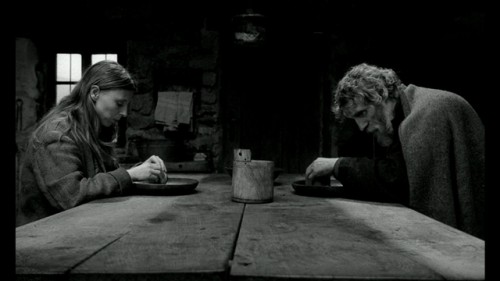
January 15th, 2014 / 10:00 am
POEM-A-DAY from THE ACADEMY OF AMERICAN LUNATICS (#10)

Sean Kilpatrick is currently writing an extended script for Out for Justice in which the villain, Richie, is not simply tossed at kitchen appliances with cheap judo, but has his bastardly say, including the following commercial stint
Ode to William Forsyth
by Sean Kilpatrick
I asked my friend Gerard Breitenbeck to portray sublime crack-smoking mafia rampage screen icon Richie, who is brought down way too quick by Steven Segal in Out for Justice. From an ode in progress honoring actor William Forsythe.
sublime crack-smoking mafia rampage screen icon Richie, who is brought down way too quick by Steven Segal in Out for Justice. From an ode in progress honoring actor William Forsythe.
note: I’ve started this feature up as a kind of homage and alternative (a companion series, if you will) to the incredible work Alex Dimitrov and the rest of the team at the The Academy of American Poets are doing. I mean it’s astonishing how they are able to get masterpieces of such stature out to the masses on an almost daily basis. But, some poems, though formidable in their own right, aren’t quite right for that pantheon. And, so I’m planning on bridging the gap. A kind of complementary series. Enjoy!
January 7th, 2014 / 10:14 pm


